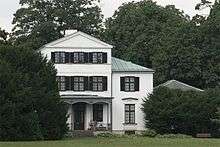Johannes Søbøtker
Johannes Søbøtker (9 May 1777 – 23 March 1854) was a Danish merchant, plantation owner and governor of St. Thomas and St. John in the Danish West Indies. His former country house Øregård in Hellerup now serves as an art museum.
Johannes Søbøtker | |
|---|---|
.jpg) | |
| Governor of St. Thomas, St. John | |
| In office 1826–1829 | |
| Monarch | Frederick VI |
| Preceded by | Peter von Scholten |
| Succeeded by | Frederik Ludvig Christian Pentz Rosenørn |
| Governor of St. Thomas, St. John | |
| In office 1836–1848 | |
| Monarch | Frederick VI /until December 1839), Christian VIII |
| Preceded by | Frederik von Oxholm |
| Succeeded by | Hans Hendrik Berg |
| Personal details | |
| Born | Peter Carl Frederik von Scholten 9 May 1777 St. Croix, Danish West Indies |
| Died | 23 March 1854 (aged 76) Frederiksberg, Denmark |
| Spouse(s) | Anne Elisabeth Thortsen ( m. 1810) |
| Parents | Casimir Wilhelm von Scholten Catharina Elisabeth de Moldrup |
| Awards | Commanders First Class of the Order of the Dannebrog |
Early life and education
Johannes Søbøtker was born on St. Croix I the Danish West Indies, the son of planter and later General War Commissioner Adam Levin Søbøtker (1753–1823) and Susanne van Beverhoudt (1761–1811). He was sent to Copenhagen where he received a commercial education first in De Coninck & Co. and later his future father-in-law Lars Larsen's trading house.
Career in Copenhagen
He was granted citizenship as a merchant and began trading on the Danish West Indies with his own fleet of merchant ships under the name Søbøtker & Co.. In 1804, Søbøtker became a partner in Vilhelm Duntzfelt's trading house, Duntzfelt & Co.[1]
Years in the Danish West Indies

He moved to the Danish West Indies and in 1821, he sold the house in Hellerup. When his father died in 1823 on St. Croix, he inherited two plantations, Constitution Hill and Høgensborg. In 1835, when Peter von Scholten was appointed to Governor General, he took over the position as governor of St. Thomas. He introduced the first steam mill in the Danish West Indies on his plantation Høgensborg.
Personal life and legacy

Søbøtker married Johanne Margrethe Larsen on 2 March 1796..
Søbøtker constructed the country house Øregård in 1806. The house was designed by Joseph-Jacques Ramée. He was known for his extravagant life style. He ran into economic problems.
In 1848, Søbøtker returned to Copenhagen. He died in Frederiksberg on 23 March 1854. He is buried at Assistens Cemetery.
He became kammerherre 1830, Knight of the Order of the Dannebrog in 1826, Dannebrogsmand and finally Commander of the Order of the Dannebrog in 1837.
His former country house Øregård opened as a museum in 1821. The park is also open to the public. Søbøtkers Allé, located a few streets from the park, is named after him.
References
- "Johannes Søbøtker" (in Danish). Dansk Biografisk Leksikon. Retrieved 1 October 2016.
External links
![]()
- Johannes Søbøtker at geni.com
- Source